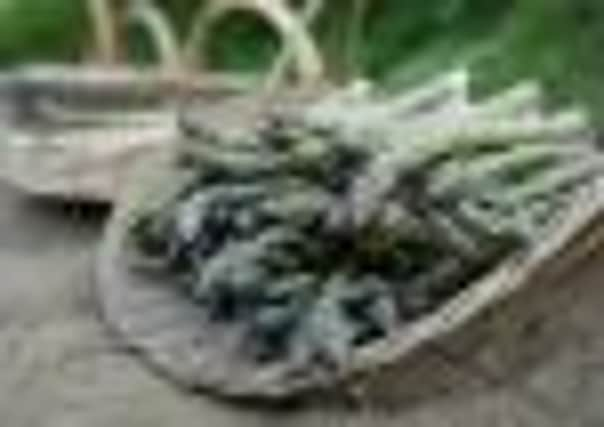Clash of the tannins


The first obvious match is Sauvignon Blanc. It already has all the right green, herbaceous notes that seem to echo asparagus, but not all Sauvignons are equally good. New Zealand Sauvignon, especially from Marlborough seems to pack just too much green-pepper, capsicum flavour into its grapes and while that can be good for salads and fish, it doesn’t always sit well with plain asparagus. Instead of Marlborough Sauvignon, head to Nelson, just around the north coast of South Island New Zealand where the weather is warmer and it gives the grapes softer, less aggressive flavours. Try Nelson Sauvignon Blanc 2011 from Marks and Spencer (£9.49) for its depth of flavour and soft, rounded yet still refreshing style of Sauvignon.
Before New Zealand Sauvignon came on stream we were quite happy to source our green grassy Sauvignons from France and that is where to find some good asparagus-friendly wines. Morrisons has L’Auberge Sauvignon 2010 (£7.99) from the Loire which is a fairly lowly Vin de Pays but the fact that it comes from Joseph Mellot who is one of the best producers of Sancerre means that this is a distinct notch up the quality scale from most Vins de Pays. Try its crisp, green aromatic fruit with a plate of asparagus and taste how well the flavours combine. Also well worth a try is La Grille Touraine Sauvignon Blanc 2011 (£6.49 Majestic on multibuy) for its citrusy, lively flavours.
Advertisement
Hide AdAdvertisement
Hide AdFor dinner party flavours trade up to Sancerre Chavignol 2011 from Paul Thomas (£11.99 Majestic on multibuy) which combines expressive citrus and gooseberry fruit with streaks of minerally freshness. This seems to capture just the right balance of fresh asparagus and wine. Alternatively try Waitrose Sancerre la Franchotte 2010 from Joseph Mellot (£12.99) and experience the flinty, fresh flavours that this excellent producer can make at the top of the appellation.
Still with green, fresh flavours but without the harsh tones of New Zealand Sauvignon, the bright, lively taste of the Verdejo grape of Rueda is also good with asparagus. Spanish Steps 2010 (£6.99 Sainsbury) has bright citrus and minerally flavours with a hint of green sherbet that copes well with plain cooked asparagus but probably won’t have enough body if you ladle on a lot of melted butter.
Of course if you have invested in one of those tall asparagus steamers then that is how you will probably cook your stems, but I could never find the space for one of these specialist cooking pots so I variously steam, grill or bake my asparagus and if you vary your cooking methods then you can vary your wine choices to suit.
Plain grilled asparagus has more texture, more roasted notes and it can cope better with wine. Try it with a bright, lively New Zealand Sauvignon if you must but I favour a Kiwi unoaked Chardonnay such as Cowrie Bay Chardonnay 2011 (£5.99 Waitrose) from Gisborne which has white peach and pear flavours and not even a hint of oak clouding its taste.
Advertisement
Hide AdAdvertisement
Hide AdGetting clean away from New Zealand and across the water to the larger island to the north, Australia has some excellent food-friendly wines that can cope with asparagus in all its forms. Start with McGuigan The Semillon 2010 (£7.99 Sainsbury) which has the right lemony flavours backed by enough weight and honeysuckle notes to cope with asparagus and Hollandaise sauce. Semillon works its magic again in Plantagenet Semillon Sauvignon 2010 (£7.99 Sainsbury) from Western Australia where the tropical fruit notes don’t dominate but add a lift of acidity and flavour to any dish with asparagus and perhaps a creamy sauce.
Once you start adding other ingredients to your asparagus dish then your wine choices open up to take account of the depth of flavour. Asparagus wrapped in prosciutto, asparagus with a walnut and butter sauce, asparagus with mushrooms and with crumbled goat’s cheese all have the need for something bigger in the glass but certainly nothing with tannin, or more than a hint of oak, and preferably no oak at all.
If you favour asparagus wrapped up in prosciutto, try the elegant, minerally, rounded flavours of La Prendina Estate Pinot Grigio 2011 from Marks and Spencer (£9.49). This comes from vineyards close to Lake Garda in Northern Italy and it has been made in a way to take out the phenolic compounds which would clash with asparagus and so the pure Pinot Grigio fruit shines through.
Asparagus with toasted walnuts and butter needs the peppery notes of Sainsbury’s Taste the Difference Grüner Veltliner 2010 (£7.99) from Austria. It musters enough clean, green-edged fruit but its pepper and light spice can cope with the nutty flavours of the dish. Once cheese and mushrooms get in on the act then the difficult nature of asparagus matching disappears in the sheer weight of flavours on the plate. Then you can head to the bigger flavours on the shelves such as a clear-fruited Pinot Noir such as Cono Sur Pinot Noir from Chile (£6.98 Asda) or a simple, lively, cherry -fruited Bardolino Naiano 2011 from Allegrini (£6.69 Majestic on multibuy).
Advertisement
Hide AdAdvertisement
Hide AdMost asparagus comes in bundles which quickly dry out, even in the covered veg drawer of the fridge, so to keep it fresh I treat mine like a bunch of daffodils, cutting off the bottom inch from the stems and then standing the spears up in an inch of water with the tops loosely covered with cling film. Stored like this in the fridge, they stay fresh and crunchy for at least a couple of days.